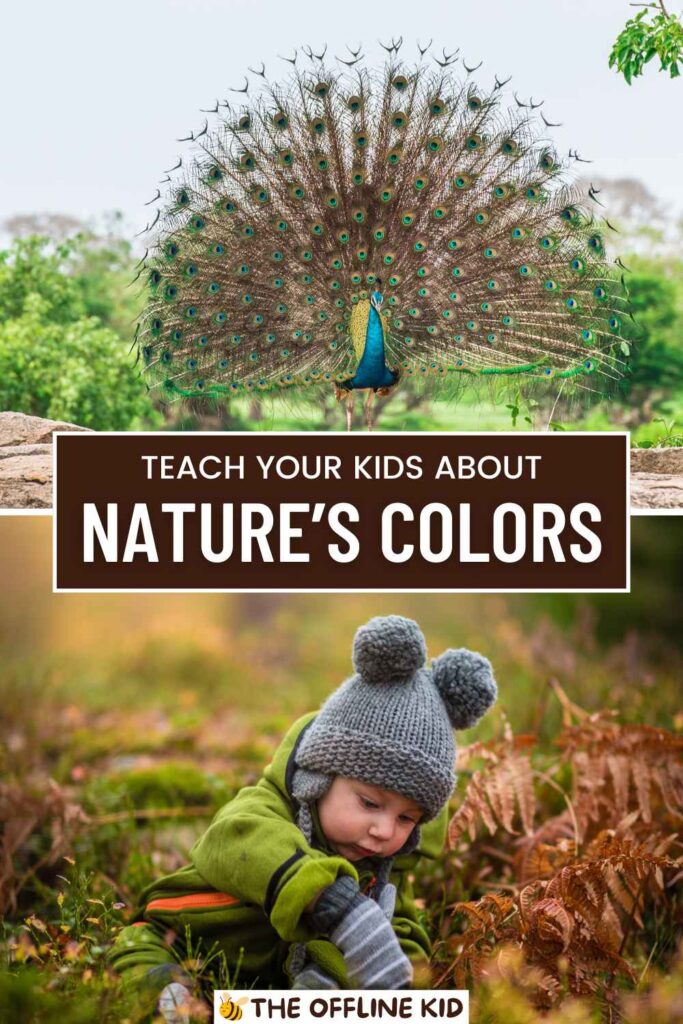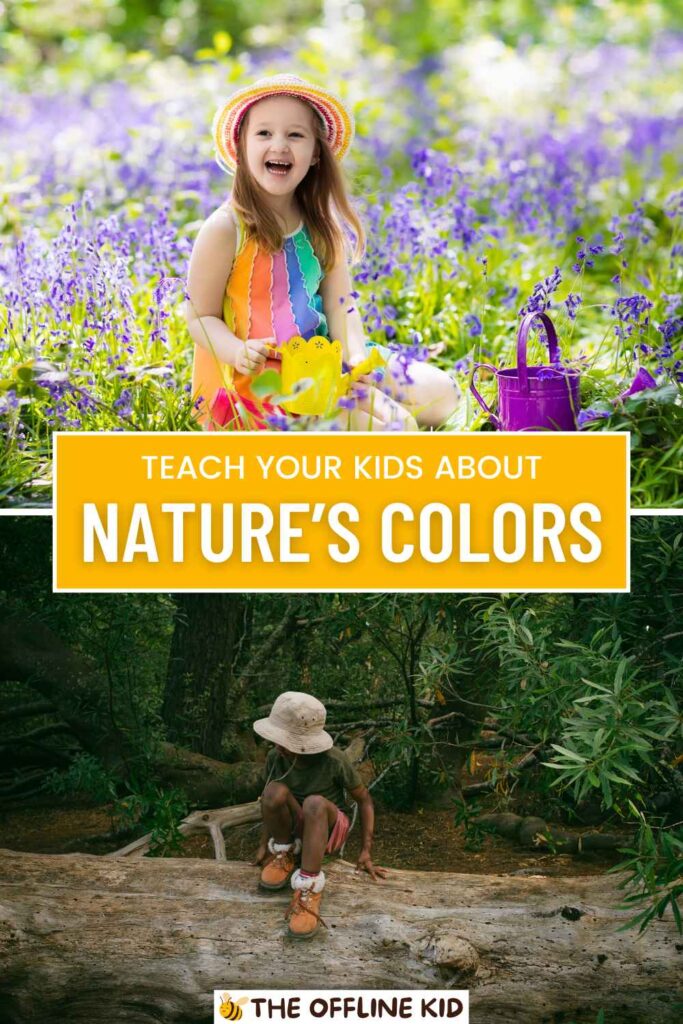Welcome to our ultimate guide on teaching kids about colors in nature!
Explore the vibrant world of natural colors and learn fun, educational activities to help your children appreciate the beauty and science of the natural world.
Understanding Colors in Nature
The Importance of Colors in Nature
Colors in nature are not just beautiful; they play a vital role in the survival and interaction of various species. Here’s why colors are important:
- Attraction: Flowers use bright colors to attract pollinators like bees and butterflies.
- Camouflage: Many animals use colors to blend into their surroundings and avoid predators.
- Warning: Some animals have bright colors to warn predators that they are toxic or dangerous.
- Communication: Animals often use colors to communicate with each other, especially during mating season.
Basic Color Theory
Understanding basic color theory can help children appreciate the complexity of colors in nature. Here are the essentials:
- Primary Colors: Red, blue, and yellow. These colors cannot be made by mixing other colors.
- Secondary Colors: Green, orange, and purple. These colors are made by mixing two primary colors.
- Red + Yellow = Orange
- Blue + Yellow = Green
- Red + Blue = Purple
- Tertiary Colors: These are made by mixing a primary color with a secondary color, such as red-orange or blue-green.
Color Wheel
Introduce your kids to the color wheel, a visual representation of colors arranged according to their chromatic relationship:
- Warm Colors: Reds, oranges, and yellows, which evoke warmth and energy.
- Cool Colors: Blues, greens, and purples, which evoke calm and relaxation.
- Complementary Colors: Colors opposite each other on the color wheel (e.g., red and green) that create a vibrant look when paired together.
Activities to Reinforce Basic Color Theory
Here are some fun and educational activities to help your kids understand and appreciate colors:
- Color Mixing Experiment: Provide primary color paints and let kids mix them to create secondary and tertiary colors.
- Color Wheel Craft: Use colored paper or paints to create a color wheel.
- Nature Color Hunt: Go on a walk and find natural objects that match the primary, secondary, and tertiary colors.
The Role of Light in Perceiving Colors
The colors we see in nature are affected by light. Here’s a simple explanation for kids:
- Sunlight and Color: Sunlight contains all colors of light. When it hits an object, some colors are absorbed, and others are reflected. The colors we see are the ones that are reflected.
- Shadows and Colors: Objects in the shade can appear to have different colors because they receive less direct light.
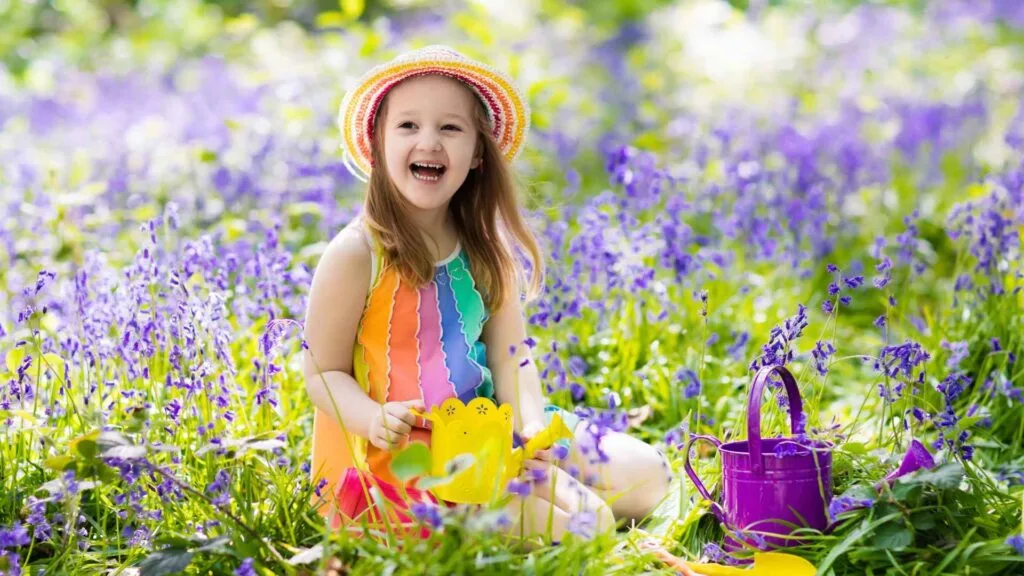
Exploring Colors in Plants
Identifying Colors in Flowers and Leaves
Plants are one of the most colorful aspects of nature. Here’s how you can help your kids explore the variety of colors in plants:
- Flower Color Walk: Take a walk in your garden, a park, or a nature reserve. Encourage your kids to identify and name different colored flowers.
- Activity: Create a flower color chart where your kids can record the colors they see and the names of the flowers.
- Leaf Color Observation: Leaves can be green, red, yellow, orange, or even purple. Encourage your kids to look closely at leaves and notice the subtle differences in shades.
- Activity: Collect different colored leaves and press them in a book to create a colorful leaf scrapbook.
Seasonal Changes in Leaf Colors
The colors of leaves change with the seasons, providing a perfect opportunity to discuss nature’s color palette:
- Spring and Summer: Leaves are usually green due to chlorophyll.
- Autumn: Leaves turn yellow, orange, and red as chlorophyll breaks down, revealing other pigments.
- Activity: Create a seasonal color wheel using leaves collected in different seasons.
The Science Behind Plant Colors
Understanding the science behind plant colors can make the exploration even more fascinating:
- Chlorophyll: This pigment gives plants their green color and is essential for photosynthesis.
- Carotenoids: These pigments produce yellow, orange, and brown colors in plants.
- Anthocyanins: These pigments can appear red, purple, or blue and are often seen in fruits and flowers.
- Betalains: Found in some plants like beets, these pigments are responsible for red and yellow hues.
How Sunlight and Soil Affect Plant Colors
The environment plays a significant role in the colors we see in plants:
- Sunlight: Plants need sunlight for photosynthesis, which produces chlorophyll. More sunlight can intensify colors in some plants.
- Activity: Grow the same plant in different light conditions and observe any differences in color.
- Soil Composition: The minerals in soil can affect plant colors. For example, hydrangeas can be blue or pink depending on the soil’s pH level.
- Activity: Conduct a simple soil test and plant the same species in different soil types to observe color variations.
Interactive Activities to Learn Plant Colors
Engaging kids with hands-on activities helps reinforce their learning:
- Flower Pressing: Collect colorful flowers, press them, and create a floral art piece.
- Leaf Rubbing: Place a leaf under a sheet of paper and rub a crayon over it to reveal the leaf’s pattern and color.
- Natural Dye Creation: Use plant materials like berries, leaves, and flowers to create natural dyes. Experiment with dyeing fabrics or paper.
By exploring the colors in plants, your kids can develop a deeper appreciation for the diversity and beauty of the natural world. These activities will not only educate them about colors but also encourage them to observe and interact with nature more closely.
Discovering Colors in Animals
Spotting Colors in Birds and Insects
Animals, especially birds and insects, display an incredible range of colors. Here’s how you can help your kids explore these colorful creatures:
- Birdwatching Adventures: Take binoculars and a bird guidebook on your walks to identify birds by their colors.
- Activity: Create a bird color chart. Note the different colors of feathers and any patterns observed.
- Insect Exploration: Look for butterflies, beetles, and other insects in your garden or a local park.
- Activity: Make a butterfly diary. Record the colors and patterns of butterflies spotted.
The Role of Colors in Animal Behavior
Animals use colors for various survival strategies. Here are some examples and activities to help your kids understand:
- Camouflage: Some animals blend into their surroundings to avoid predators.
- Example: The green tree frog blends into leaves.
- Activity: Play a camouflage game where kids hide colored objects in nature.
- Mimicry: Some animals mimic the appearance of more dangerous species.
- Example: The harmless viceroy butterfly mimics the toxic monarch butterfly.
- Activity: Compare pictures of mimicking animals and the species they imitate.
- Warning Colors: Bright colors can warn predators that an animal is poisonous or dangerous.
- Example: Poison dart frogs have bright colors.
- Activity: Draw pictures of animals with warning colors and discuss why they need them.
Exploring the Colors of Fish and Marine Life
The underwater world is full of vibrant colors. Here’s how you can introduce your kids to these aquatic wonders:
- Visit an Aquarium: An aquarium visit provides a firsthand look at colorful fish and marine creatures.
- Activity: Create a fish color guide. Identify and record the colors of different fish.
- Tide Pool Exploration: Visit tide pools to observe colorful marine life like starfish, crabs, and anemones.
- Activity: Make a tide pool observation journal. Note the colors and behaviors of the creatures found.
How Animals Use Colors for Mating
Many animals use bright colors to attract mates. Here are some examples and activities:
- Birds: Male birds often have brighter colors than females to attract a mate.
- Example: The peacock’s colorful tail feathers.
- Activity: Watch documentaries or videos about bird courtship displays and discuss with your kids.
- Fish: Some fish change colors during mating season.
- Example: The male mandarin fish becomes more vibrant to attract females.
- Activity: Draw and color pictures of fish before and during mating season.
Interactive Activities to Learn Animal Colors
Engaging kids with hands-on activities helps reinforce their learning:
- Animal Coloring Books: Use coloring books featuring animals to help kids learn and remember different colors.
- Nature Photography: Encourage kids to take photos of colorful animals and create a photo album or slideshow.
- DIY Animal Masks: Create animal masks using colored paper and other craft supplies. Focus on the animal’s colors and patterns.
Learning Through Observation and Art
Combining observation with creative activities can deepen your child’s understanding and appreciation of animal colors:
- Field Sketching: Bring sketchbooks and colored pencils on nature walks. Encourage your kids to draw and color the animals they see.
- Animal Collage: Create a collage of different animals using magazines, colored paper, and other materials. Focus on replicating the colors and patterns accurately.
By discovering the colors in animals, your kids can learn about the diverse and fascinating strategies animals use to survive and thrive. These activities will not only educate them about colors but also foster a greater appreciation for wildlife and the natural world.
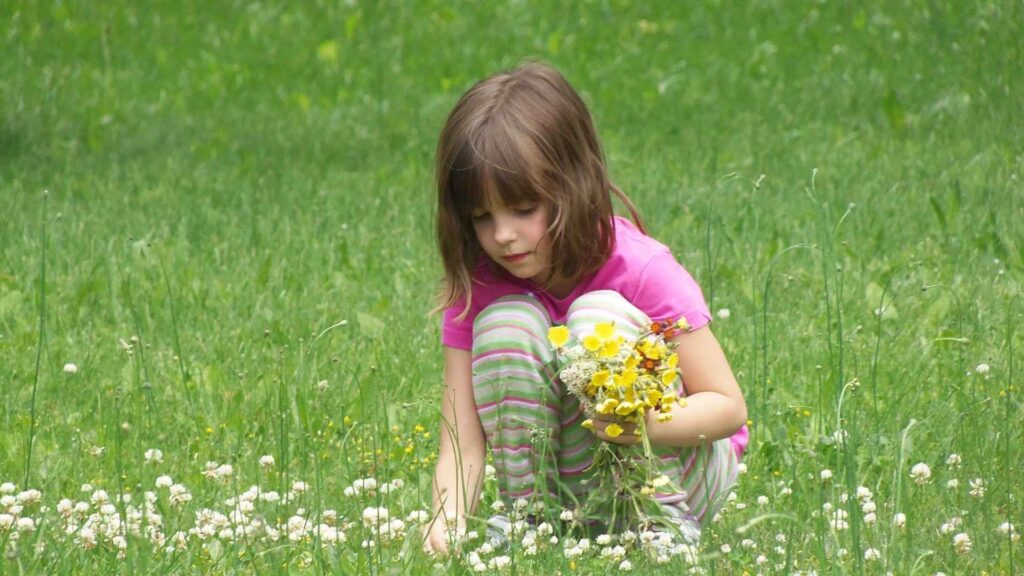
Observing Colors in Water and Sky
Colors of the Sky
The sky offers a daily display of beautiful colors. Here’s how you can help your kids explore and understand these colors:
- Sunrise and Sunset Observation: Watch the sky during sunrise and sunset to see a range of colors from reds and pinks to oranges and purples.
- Activity: Create a sunrise/sunset diary. Have your kids draw or paint the colors they observe each day.
- Weather and Sky Colors: Different weather conditions can change the colors of the sky.
- Example: A clear blue sky on a sunny day versus the gray of an overcast day.
- Activity: Make a weather journal. Record the sky’s colors and match them to different weather conditions.
Why the Sky Changes Colors
Understanding the science behind the sky’s colors can make observations more interesting:
- Rayleigh Scattering: This phenomenon explains why the sky is blue during the day and changes color during sunrise and sunset.
- Explanation: Blue light is scattered in all directions by the gases and particles in the Earth’s atmosphere. During sunrise and sunset, the light has to pass through more atmosphere, scattering the shorter wavelengths and allowing the longer red and orange wavelengths to dominate.
- Activity: Perform a simple scattering experiment using a flashlight and a glass of water with a few drops of milk. Shine the flashlight through the water and observe how the light changes color.
Colors in Bodies of Water
Water can display a variety of colors depending on several factors. Here’s how you can help your kids explore these colors:
- Shades of Blue and Green: Observe different bodies of water like oceans, lakes, and rivers.
- Activity: Create a water color chart. Record the colors of different water bodies observed during trips.
- Reflection and Absorption: Water colors can change due to reflection of the sky and absorption of light.
- Example: A calm lake might reflect the blue sky, while a deeper ocean might appear a darker blue due to light absorption.
- Activity: Use colored paper to simulate different water depths and discuss how light absorption changes the appearance of water.
Exploring Color Changes in Water
Different conditions can cause water to change colors. Here’s how to explore these changes:
- Algae Blooms: Algae can turn water green or even red during a bloom.
- Example: Red tides caused by certain types of algae.
- Activity: Discuss the impact of algae blooms on aquatic life and water quality.
- Mineral Content: Minerals dissolved in water can affect its color.
- Example: Iron-rich water may appear reddish-brown.
- Activity: Conduct a water testing experiment to check for minerals and discuss how they influence color.
Interactive Activities to Learn About Water and Sky Colors
Engaging kids with hands-on activities helps reinforce their learning:
- Sky in a Jar: Create a mini sky using a clear jar, water, and a flashlight to demonstrate how light scattering works.
- Water Color Mixing: Use food coloring to create different shades of blue and green in water. Discuss how these colors compare to natural water bodies.
- Outdoor Water Painting: Paint or draw outdoor scenes featuring bodies of water and the sky. Focus on capturing the colors accurately.
Learning Through Books and Media
Books and media can provide additional insights and activities:
- Recommended Books:
- “All the Colors of the Rainbow” by Allan Fowler
- “Sky Color” by Peter H. Reynolds
- “A Drop of Water: A Book of Science and Wonder” by Walter Wick
- Educational Videos:
- Watch documentaries or educational videos about the water cycle, the atmosphere, and natural phenomena like rainbows.
- Explore apps that simulate weather patterns and sky changes.
By observing the colors in water and the sky, your kids can develop a deeper understanding of natural phenomena and the science behind them. These activities will not only educate them about colors but also inspire a sense of wonder and curiosity about the natural world.
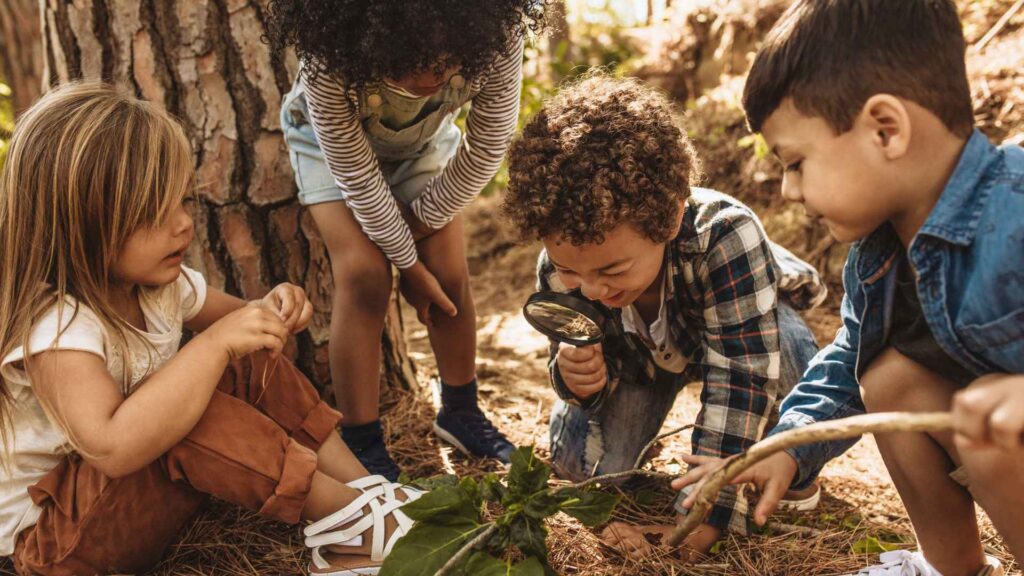
Interactive Activities to Learn Colors
Nature Walks and Color Hunts
Exploring nature firsthand is one of the best ways to teach kids about colors. Here’s how to make your nature walks educational and fun:
- Organizing Nature Walks:
- Choose a local park, garden, or nature trail.
- Bring along color charts and notebooks for recording observations.
- Color Hunts:
- Activity: Create a scavenger hunt list with specific colors to find. For example, “Find something red,” “Find a yellow flower,” etc.
- Activity: Use paint sample cards from a hardware store as color swatches. Match natural objects to these colors during the walk.
- Nature Art Collecting:
- Activity: Collect natural items like leaves, flowers, and rocks. Use these items to create a color collage when you return home.
Art Projects Using Natural Materials
Art projects can be a creative way to reinforce color learning:
- Nature-Inspired Art:
- Activity: Gather leaves, flowers, and other natural items. Use them to create a collage or nature mandala.
- Making Natural Dyes:
- Activity: Create natural dyes from plant materials like berries, spinach, and turmeric. Use these dyes to color fabric or paper.
- Leaf Printing:
- Activity: Paint the surface of leaves and press them onto paper to create prints. Experiment with different colors and leaf shapes.
Creating a Nature Journal
A nature journal helps kids document their color discoveries and encourages regular observation:
- Setting Up the Journal:
- Provide a blank notebook, colored pencils, and markers.
- Encourage your kids to personalize the cover with drawings or stickers.
- Recording Observations:
- Activity: Draw or paint pictures of plants, animals, and landscapes observed during nature walks.
- Activity: Write short descriptions of the colors seen and any interesting facts learned.
- Seasonal Changes:
- Activity: Track how colors in nature change with the seasons. Create a seasonal color wheel or timeline in the journal.
Nature-Themed Crafts
Crafts can bring a bit of nature indoors and allow kids to explore colors creatively:
- Pressed Flower Art:
- Activity: Press flowers between heavy books for a week. Use the pressed flowers to make bookmarks, cards, or framed art.
- Rock Painting:
- Activity: Collect smooth rocks and paint them with vibrant colors and patterns. Use them to decorate the garden or home.
- Bird Feeder Making:
- Activity: Create bird feeders using pine cones, peanut butter, and birdseed. Hang them in the yard and observe the colorful birds they attract.
Educational Games and Activities
Interactive games can make learning about colors fun and engaging:
- Color Bingo:
- Activity: Create bingo cards with different colors. As you explore nature, mark off the colors you find.
- Color Sorting:
- Activity: Collect natural items and sort them by color. Discuss the variations and shades within each color group.
- Color Memory Game:
- Activity: Create a memory game with pairs of cards showing different natural items and their colors. Turn the cards face down and try to find matching pairs.
Using Technology to Explore Colors in Nature
Incorporating technology can enhance the learning experience:
- Photography:
- Activity: Use a digital camera or smartphone to take photos of colorful objects in nature. Create a digital color journal or slideshow.
- Color Identification Apps:
- Activity: Use apps that identify colors and provide information about plants and animals. Apps like Seek by iNaturalist can be very educational.
- Online Research:
- Activity: Look up interesting facts about the colors of specific plants and animals. Create a presentation or poster to share what you’ve learned.
Creating a Nature Color Wheel
A nature color wheel helps kids see the full spectrum of colors in the natural world:
- Gathering Materials:
- Collect items in nature that represent different colors.
- Assembling the Wheel:
- Glue or tape the collected items onto a circular piece of cardboard, arranging them in the order of the color wheel.
- Discussing Findings:
- Talk about the different shades and where each color is commonly found in nature.
By engaging in these interactive activities, your kids can develop a deeper appreciation for the vibrant colors found in the natural world. These hands-on experiences not only make learning about colors fun but also foster a lifelong connection to nature.
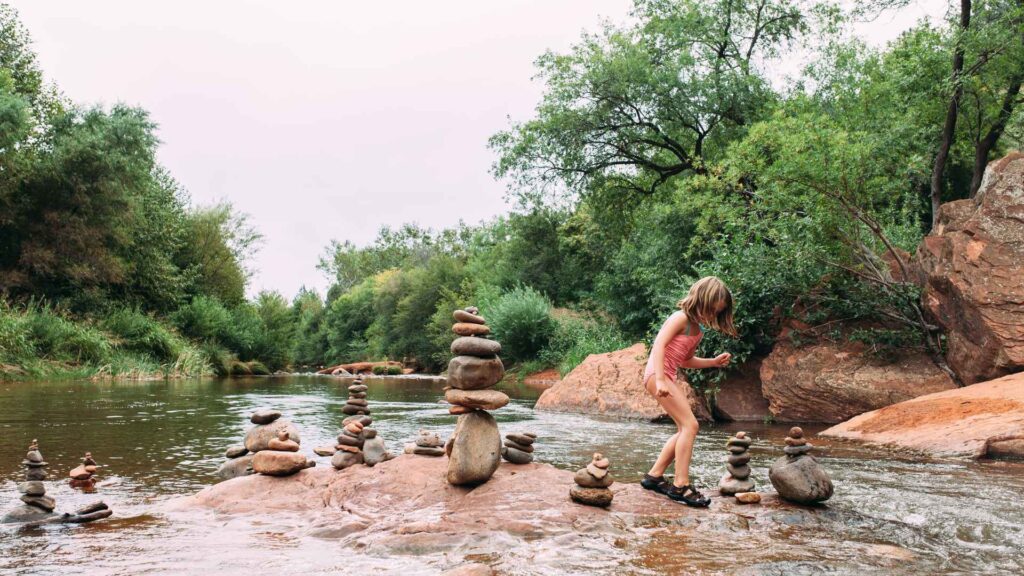
Experiments and Science Projects
Simple Experiments to Explore Colors
Hands-on experiments are a great way to make learning about colors in nature both fun and educational. Here are some simple experiments to try:
- Color Chromatography:
- Materials Needed: Coffee filters, washable markers, a cup of water.
- Activity: Draw a thick line near the bottom of a coffee filter strip with different colored markers. Dip the very tip of the strip into a cup of water and watch as the water travels up, separating the colors into different pigments. Discuss how this relates to natural pigments in plants.
- Rainbow Jar:
- Materials Needed: Clear jar, water, food coloring, sugar, measuring cups.
- Activity: Create layers of colored water in a jar by adding different amounts of sugar to each layer (e.g., 1 tablespoon, 2 tablespoons, etc.) and coloring them with food dye. Carefully layer the colored water from most dense to least dense. Observe the layers and discuss the concept of density and light refraction.
- Leaf Color Experiment:
- Materials Needed: Green leaves, rubbing alcohol, glass jar, plastic bag, hot water.
- Activity: Place a few green leaves in a glass jar, cover them with rubbing alcohol, and mash them up. Seal the jar with a plastic bag and place it in a container of hot water. After an hour, observe the liquid. Discuss how the chlorophyll breaks down and the other pigments become visible.
Science Projects that Demonstrate Color Changes
Engage kids in longer-term science projects that show how colors change in nature:
- Plant Pigment Observation:
- Activity: Plant different types of flowers in your garden or pots. Observe and record the color changes as they grow, noting the effect of sunlight, water, and soil.
- Discussion: Talk about how different pigments (chlorophyll, carotenoids, anthocyanins) affect plant colors.
- Butterfly Garden:
- Activity: Plant a variety of flowers known to attract butterflies. Observe the butterflies that visit and record the colors and patterns on their wings.
- Discussion: Discuss why butterflies have such colorful wings and how they use colors for survival.
- Sunlight and Color Fading:
- Materials Needed: Construction paper, scissors, tape.
- Activity: Cut shapes out of different colored construction paper. Tape them to a sunny window and observe over a few weeks how the colors fade.
- Discussion: Talk about the effects of sunlight on colors and how this happens in nature.
Building a Nature Journal
Encourage your kids to document their findings in a nature journal:
- Setting Up the Journal:
- Materials Needed: Blank notebook, colored pencils, markers, stickers.
- Activity: Personalize the journal cover. Use sections to record observations, sketches, and photos.
- Example Entries: Record the date, location, and weather conditions. Sketch plants and animals observed and note their colors. Include pressed leaves or flower petals.
- Regular Entries:
- Activity: Make regular entries about seasonal changes, experiments, and projects.
- Discussion: Review past entries to observe patterns and changes over time.
Interactive Science Projects for Different Seasons
Each season offers unique opportunities to observe and experiment with colors in nature:
- Spring:
- Project: Grow a rainbow garden with flowers of different colors. Track their growth and colors over time.
- Activity: Create a spring color chart and match blooms to colors.
- Summer:
- Project: Study the colors of different insects like butterflies, beetles, and dragonflies.
- Activity: Make a collage of insect photos or drawings.
- Autumn:
- Project: Observe and document the changing colors of leaves.
- Activity: Create a leaf color chart and press leaves for crafts.
- Winter:
- Project: Study the colors of birds that visit feeders and compare their winter plumage to summer plumage.
- Activity: Make birdseed ornaments and observe which birds are attracted to them.
Simple Science Fair Projects
If your kids are interested in science fairs, here are some color-related project ideas:
- Project: The Effect of Light on Plant Growth
- Hypothesis: Plants grown under different colored lights will grow differently.
- Experiment: Grow plants under red, blue, and white lights and measure their growth.
- Conclusion: Discuss how different wavelengths of light affect plant growth.
- Project: Color Preference in Birds
- Hypothesis: Birds will prefer certain colors of bird feeders.
- Experiment: Paint bird feeders in different colors and observe which ones attract the most birds.
- Conclusion: Discuss how color plays a role in bird behavior and preference.
By conducting these experiments and science projects, your kids can gain a deeper understanding of the role colors play in nature. These activities will not only teach them about scientific principles but also encourage curiosity and critical thinking.
Seasonal Color Changes
Exploring Colors in Different Seasons
Each season brings its own unique palette of colors. Here’s how you can help your kids observe and appreciate these seasonal changes:
- Spring:
- Colors: Fresh greens, bright yellows, pinks, and purples.
- Activities:
- Flower Bloom Tracking: Keep a diary of when different flowers start to bloom and their colors.
- Spring Scavenger Hunt: Create a list of spring colors to find on a nature walk, such as yellow daffodils, pink cherry blossoms, and green budding leaves.
- Summer:
- Colors: Deep greens, vibrant blues, bright reds, and oranges.
- Activities:
- Beach Colors Exploration: Collect colorful shells, pebbles, and sea glass at the beach. Discuss how water and sunlight create different shades.
- Summer Garden Journal: Document the colors of fruits, vegetables, and flowers in a summer garden. Note how sunlight affects their hues.
- Autumn:
- Colors: Warm oranges, reds, yellows, and browns.
- Activities:
- Leaf Color Wheel: Collect leaves in various colors and arrange them in a wheel to show the progression of fall colors.
- Fall Leaf Collage: Press and dry leaves, then use them to create a colorful collage or artwork.
- Winter:
- Colors: Cool blues, whites, grays, and occasional bursts of red and green.
- Activities:
- Winter Sky Watching: Observe and draw the different colors of the sky during winter, including sunsets and snowy landscapes.
- Winter Bird Study: Watch for birds that remain in the area during winter and note their colors against the snowy background.
Holiday-Themed Color Activities
Holidays provide a perfect opportunity to explore colors in nature. Here are some activities to celebrate the seasons and their associated colors:
- Spring Holidays (Easter, Earth Day):
- Easter Egg Dyeing: Use natural dyes from plants like beetroot, spinach, and turmeric to color Easter eggs.
- Earth Day Nature Art: Collect natural materials to create Earth Day-themed art projects highlighting the colors of spring.
- Summer Holidays (Fourth of July):
- Patriotic Colors Hunt: Look for red, white, and blue items in nature, such as flowers, berries, and the sky.
- Beach Art: Create sand sculptures or beach collages using natural materials found on the shore.
- Autumn Holidays (Halloween, Thanksgiving):
- Pumpkin Painting: Instead of carving, paint pumpkins with vibrant autumn colors and patterns.
- Thanksgiving Nature Centerpiece: Collect autumn leaves, pinecones, and acorns to create a colorful table centerpiece.
- Winter Holidays (Christmas, Hanukkah):
- Pinecone Ornaments: Collect pinecones and decorate them with paint, glitter, and natural materials to make holiday ornaments.
- Winter Wonderland Art: Use white paint and natural materials to create winter-themed art, like snowy landscapes or icicle decorations.
Seasonal Nature Journals
Encourage your kids to maintain a nature journal throughout the year to track seasonal changes and colors:
- Setup:
- Materials Needed: Blank journal, colored pencils, markers, glue, and tape.
- Personalization: Let your kids decorate the cover and divide the journal into seasonal sections.
- Regular Entries:
- Activity: Record observations of plants, animals, and landscapes in each season. Include sketches, pressed leaves, and photos.
- Reflection: Encourage your kids to write about the changes they observe and how they feel about each season’s colors.
Seasonal Science Projects
Engage your kids in science projects that highlight seasonal color changes:
- Spring:
- Project: Planting a Rainbow Garden
- Activity: Plant flowers in a variety of colors and track their growth and blooming times.
- Summer:
- Project: Solar-Powered Colors
- Activity: Create solar prints using sun-sensitive paper and natural objects. Discuss how sunlight creates different shades.
- Autumn:
- Project: Leaf Color Investigation
- Activity: Collect leaves in different colors and perform experiments to extract pigments using rubbing alcohol and coffee filters.
- Winter:
- Project: Snow and Ice Colors
- Activity: Observe and document the colors of snow and ice in different lights. Create ice sculptures using colored water and molds.
By exploring the colors of each season through these activities, your kids can develop a deeper appreciation for the cyclical nature of the environment.
These hands-on experiences will help them understand the significance of seasonal changes and the beautiful array of colors that each season brings.
